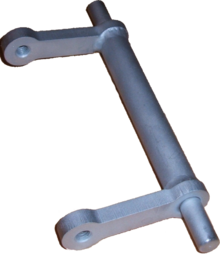- Chrome plating
-
This article is about a chromium electroplating technique. For other uses, see Chrome (disambiguation).
Chrome plating, often referred to simply as chrome, is a technique of electroplating a thin layer of chromium onto a metal object. The chromed layer can be decorative, provide corrosion resistance, ease cleaning procedures, or increase surface hardness.
Contents
Process
A component to be chrome plated will generally go through these different stages:
- degreasing to remove heavy soiling;
- manual cleaning to remove all residual traces of dirt and surface impurities;
- various pretreatments depending on the substrate;
- placement into the chrome plating vat, where it is allowed to warm to solution temperature; and
- application of plating current, under which the component is left for the required time to attain thickness.
There are many variations to this process depending on the type of substrate being plated upon. Different etching solutions are used for different substrates. Hydrochloric, hydrofluoric, and sulfuric acids can be used. Ferric chloride is also popular for the etching of Nimonic alloys. Sometimes the component will enter the chrome plating vat electrically live. Sometimes the component will have a conforming anode either made from lead/tin or platinized titanium. A typical hard chrome vat will plate at about 25 micrometres (0.00098 in) per hour.
Various Linishing and Buffing processes are used in preparing components for decorative chrome plating. The overall appearance of decorative chrome plating is only as good as the preparation of the component.[1]
The chrome plating chemicals are very toxic. Disposal of chemicals is regulated in most countries.
Hexavalent chromium
Hexavalent chromium plating, also known as hex-chrome, Cr+6, and chrome (VI) plating, uses chromic anhydride, also known as chromium trioxide, as the main ingredient. Hexavalent chromium plating solution is used for decorative and hard plating, along with bright dipping of copper alloys, chromic acid anodizing, and chromate conversion coating.[2]
A typical hexavalent chromium plating process is: (1) activation bath, (2) chromium bath, (3) rinse, and (4) rinse. The activation bath is typically a tank of chromic acid with a reverse current run through it; this etches the workpiece surface and removes any scale. In some cases the activation step is done in the chromium bath. The chromium bath is a mixture of chromic acid (CrO3) and Sulfuric acid (sulfate, SO4); the ratio of which varies greatly between 75:1 to 250:1 by weight. This results in an extremely acidic bath (pH 0). The temperature and current density in the bath affect the brightness and final coverage. For decorative coating the temperature ranges from 95 to 115 °F (35 to 46 °C), but for hard coating it ranges from 120 to 150 °F (49 to 66 °C). Temperature is also dependent on the current density, because a higher current density requires a higher temperature. Finally, the whole bath is agitated to keep temperature steady and increase a uniform deposition.[2]
Disadvantages
One functional disadvantage of hexavalent chromium plating is low cathode efficiency, which results in bad throwing power. This means it leaves a non-uniform coating, with more on edges and less in inside corners and holes. To overcome this problem the part may be over-plated and ground to size, or auxiliary anodes are used around the hard-to-plate areas.[2]
From a health standpoint, hexavalent chromium is the most toxic form of chromium. In the U.S. it is heavily regulated by the Environmental Protection Agency (EPA); the EPA lists it as a hazardous air pollutant because it is a human carcinogen, a "priority pollutant" under the Clean Water Act, and a "hazardous constituent" under the Resource Conservation and Recovery Act. Due to the low cathodic efficiency and high solution viscosity a mist of water and hexavalent chromium is released from the bath, which is toxic. To control these emissions wet scrubbers are used. The discharge from the wet scrubbers is then treated to precipitate the chromium from the solution, because it cannot be discarded in the waste water.[2]
Maintaining a bath surface tension less than 35 dynes/cm requires frequent cycle of treating the bath by a wetting agent and confirming the effect on surface tension.[3] Traditionally surface tension is measured by a stalagmometer. This method is, however, tedious and suffers from inaccuracy (errors up 22 dynes/cm has been reported), and is dependent on user's experience and capabilities.[4]
Additional toxic waste that is created from hexavalent chromium baths include lead chromates which form in the bath because lead anodes are used. Barium is also used to control the sulfate concentration, which leads to the formation of barium sulfate, a hazardous waste.[2]
Trivalent chromium
Trivalent chromium plating, also known as tri-chrome, Cr+3, and chrome (III) plating, uses chromium sulfate or chromium chloride as the main ingredient. Trivalent chromium plating is an alternative to hexavalent chromium in certain applications and thicknesses (e.g. decorative plating).[2]
A trivalent chromium plating process is similar to the hexavalent chromium plating process except for the bath chemistry and anode composition. There are three main types of trivalent chromium bath configurations:[2]
- A chloride- or sulfate-based electrolyte bath using graphite or composite anodes, plus additives to prevent the oxidation of trivalent chromium to the anodes.
- A sulfate-based bath that uses lead anodes that are surrounded by boxes filled with sulfuric acid (known as shielded anodes), which keeps the trivalent chromium from oxidizing at the anodes.
- A sulfate-based bath that uses insoluble catalytic anodes, which maintains an electrode potential that prevents oxidation.
The trivalent chromium plating process plates workpieces at a similar temperature, rate and hardness, as compared to hexavalent chromium. Plating thickness range from 0.005 to 0.050 mil (0.00013 to 0.0013 mm).[2]
Advantages and disadvantages
The functional advantages of trivalent chromium are higher cathode efficiency and better throwing power. The better throwing power means production rates are greater. Less energy is required because of the lower current densities required. The process is more robust than hexavalent chromium because it can withstand current interruptions.[2]
From a health standpoint trivalent chromium is intrinsically less toxic than hexavalent chromium. Because of the lower toxicity it is not regulated as toughly, which reduces overhead costs. There are other secondary health advantages:[2]
- Higher cathode efficiencies lead to less chromium emitted into the air
- Lower concentration levels result in less chromium waste
- The anodes do not discompose
One of the disadvantages when the process was first introduced was that decorative customers disapproved of the color differences, however additives are now used to adjust the color. In hard coating applications, the corrosion resistance of thicker coatings is not quite as good as hexavalent chromium. The cost of the chemicals is greater, however this is usually offset by greater production rates and lower overhead costs. In general, the process must be controlled more closely than in hexavalent chromium plating, especially with respect to metallic impurities. This means processes that are hard to control, such as barrel plating, are much more difficult using a trivalent chromium bath.[2]
Types
Decorative
Decorative chrome is designed to be aesthetically pleasing and durable. Thicknesses range from 0.002 to 0.020 mil (0.00005–0.0005 mm), however they are usually between 0.005 and 0.010 mil (0.00013 and 0.00025 mm). The chromium plating is usually applied over bright nickel plating. Typical base materials include steel, aluminum, plastic, copper alloys, and zinc alloys.[2]
Hard
Hard chrome, also known as industrial chrome or engineered chrome, is used to reduce friction, add wear resistance, or increase corrosion resistance.[5] It is very hard, measuring between 66 to 70 HRC. Hard chrome tends to be thicker than the decorative treatment, typically ranging from 0.075 to 0.25 millimetre (0.0030 to 0.0098 in), but can range from 0.005 to 0.01 mil (0.00013 to 0.00025 mm).[2] Surface defects and roughness are amplified, because hard chrome does not have a leveling effect.[6] Hard chromium plating is subject to different types of quality requirements depending on the application, for instance, the plating on hydraulic piston rods are tested for corrosion resistance with a salt spray test.
Automotive use
Formerly most decorative items affixed to cars were referred to as "chrome", by which phrase was actually meant steel that had undergone several plating processes to endure the temperature changes and weather that a car was subject to outdoors. The most expensive and durable process involved plating the steel first with copper, and then nickel, before the chromium plating was applied.
Prior to the application of chrome in the 1920s, nickel electroplating was used. In the US for the short production run prior to the entry into the Second World War, plating was banned to save chromium and the decorative pieces were painted in a complementary color. In the last years of the Korean War, the banning of chrome was contemplated and several cheaper processes (such as plating with zinc and then coating with shiny plastic) were considered.
In 2007, a Restriction of Hazardous Substances Directive (RoHS) was issued banning several toxic substances for use in the automotive industry in Europe, including hexavalent chromium, which is used in chrome plating.
See also
References
- ^ "Chrome Plating Process". Ashford Chroming. http://www.ashfordchroming.com/chroming-process. Retrieved 2010-09-27.
- ^ a b c d e f g h i j k l m Pollution Prevention Technology Profile Trivalent Chromium Replacements for Hexavalent Chromium Plating, Northeast Waste Management Officials’ Association, 2003-10-18, archived from the original on 2010-08-06, http://www.webcitation.org/5rn3zeIjt.
- ^ http://www.epa.gov/ttn/atw/chrome/chromepg.html
- ^ http://www.nmfrc.org/crarchive/jan08b.cfm
- ^ QQ-C-320B
- ^ Degarmo, E. Paul; Black, J T.; Kohser, Ronald A. (2003), Materials and Processes in Manufacturing (9th ed.), Wiley, p. 793, ISBN 0-471-65653-4.
Further reading
- SAE AMS 2406
- SAE AMS 2438
- SAE AMS 2460 - Plating, Chromium
Categories:- Automotive styling features
- Chromium
- Corrosion prevention
- Metal plating
Wikimedia Foundation. 2010.


